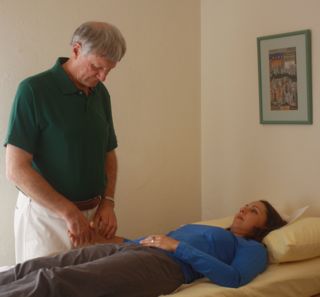Thirty years ago when I first began to study Chinese medicine I found that the most challenging aspect of the course was learning how to take pulses. In Chinese medicine taking the pulse is a very intricate and refined means of assessing what is going on with a patient’s chi or vital energy. Most of us are all familiar with the western medical method of pulse taking, which consists of taking the pulse rate on the radial artery on the forearm. In western medicine the focus of pulse taking is on the rate that the heart is pumping blood, and the speed of the pulse is the primary factor that is noted.
The purpose of taking the pulse in Chinese medicine is to monitor the flow and quality of the twelve energy channels in the body. It is a sophisticated and intricate skill and consequently takes many years of practice to master. In Chinese medicine there are twelve different pulses. These are usually taken on the radial artery of each wrist, using three different positions and two depths. Each channel of energy, such as the Heart, Liver, Spleen, Stomach, etc. has a separate pulse. In the first few months of my training I often found it hard to locate the twelve pulses and quite often I could not distinguish the pulse quality. Gradually, as I kept practicing taking pulses on my family, friends and fellow students, my sense of touch began to develop. I began to realize that an incredible amount of information about the patient’s state of health is literally available at my fingertips.
I found that through taking the pulses, I could assess not only the movement of the chi at the physical level, but also at the level of the emotions and spirit. Since the basis of Chinese medicine is that the underlying cause of illness is an imbalance within the vital life energy or chi, it is essential for the practitioner to be able to assess the nature and quality of the chi throughout the meridian system.
Ideally, all of the twelve pulses should have a harmonious quality of a medium strength. In reality, the pulse of most patients reflects imbalances within the chi. These imbalances can manifest in many different pulse pictures. Traditional texts on acupuncture describe at least 25 different qualities that can be detected on the pulse. These include empty, floating, slippery, hollow and deep.
Probably the  most common type of pulse imbalance is one that is deficient. Instead of having a vibrant, strong quality, the pulse is weak. This type of pulse indicates that the patient’s energy needs to be strengthened.
most common type of pulse imbalance is one that is deficient. Instead of having a vibrant, strong quality, the pulse is weak. This type of pulse indicates that the patient’s energy needs to be strengthened.
The opposite situation occurs when the pulse, instead of being weak, is too forceful. The pulse has a pounding, throbbing quality. A patient who has a pounding headache would probably have an excess pulse picture.
Another time when the pulse is in excess is when there is an acute infection such as a cold or flu, then the pulses will change dramatically. Usually they become much bigger and more forceful. This is because in an acute infection the defensive chi rises upward of the invasion of the pathogen, and consequently the pulse is stronger.
Monitoring the Pulse During Treatment
In my third year at college I began my clinical studies, and under supervision I began treating patients. I found this immensely rewarding and interesting. One of the main realizations I had in these months was how quickly, instantly in many cases, the pulses change during a treatment. This is immensely helpful in gauging how a patient is responding to a treatment.
Usually the pulse is taken at the beginning of each treatment, its general quality and the relative quality to the other pulses is noted. In the case of patients who have had previous treatment, the pulse picture is compared to previous visits. As the treatment progresses, the pulse is checked frequently to assess the effect of the points that have been used, and to determine what other points or herbal formulas will be needed. Only when there has been a significant improvement in all the patient’s pulses is the treatment concluded.
(originally published in the Petaluma360)